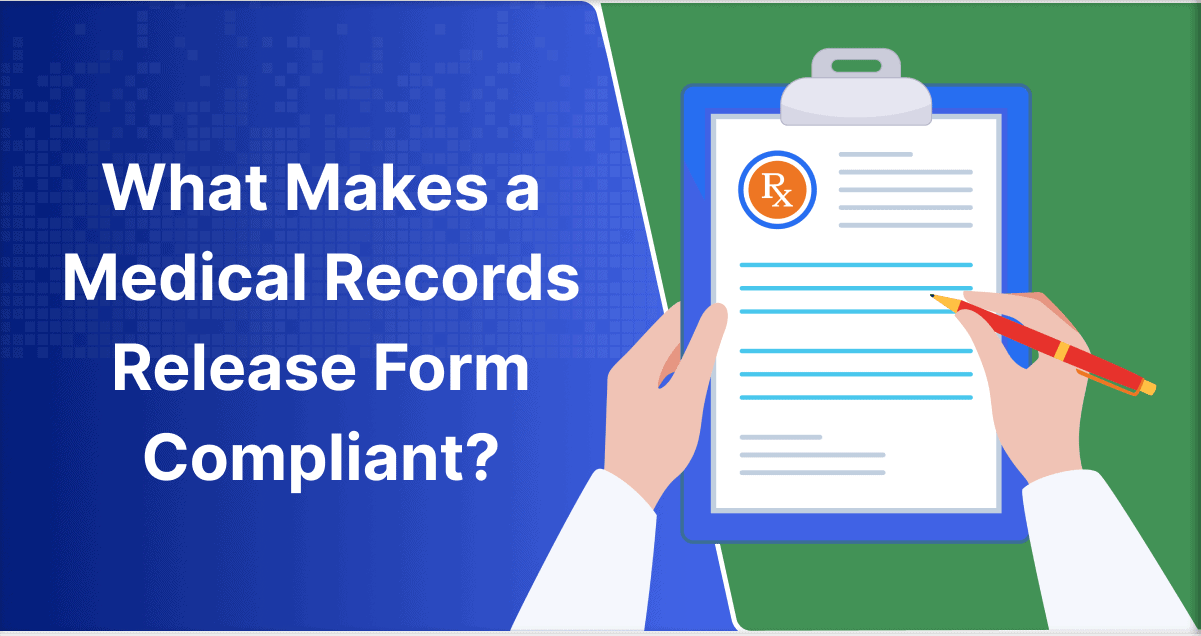Compliant medical records release forms help protect sensitive patient information by ensuring healthcare professionals only perform the release of information (ROI) with patient consent.
Medical records contain sensitive information that requires diligent protection. This is one of the reasons why releasing medical records can be lengthy and difficult.
One critical aspect of this process is obtaining a signed medical records release form from the patient or their legal guardian. This document serves as written consent for transferring medical records and ensures that the process complies with HIPAA’s Privacy Rule.
Healthcare professionals must validate and approve requests for medical records before releasing them. Given the potentially lengthy process for each transaction, ensuring the accuracy of every medical records release form is important.
In this article, let’s find out what makes a medical records release form proper and compliant. We will also include tips on how to avoid common compliance pitfalls, so you can avoid potential violations that can lead to steep HIPAA fines.
What is a Medical Records Release Form
A medical records release form is a document that authorizes the release of patient health information from one healthcare provider to another. This form also allows for the transfer of medical records between a healthcare provider and an insurance company, legal team, or any other authorized entity.
The primary purpose of this form is to protect patients’ privacy by ensuring healthcare professionals only share sensitive health information with authorized individuals or organizations.
8 Key Elements of a Compliant Medical Records Release Form
A study by the American Health Information Management Association revealed that up to 50% of denied claims stemmed from inadequate patient identification. This emphasizes the importance of well-structured and compliant release forms.
A proper and compliant medical records release form should include the following essential elements:
1. Patient Information
The first section of the form should contain the patient’s personal information, such as their full name, date of birth, address, and contact details. This information helps healthcare professionals identify the patient and release the correct medical records. It’s especially helpful when an organization has multiple patients with the same name.
2. Purpose of Request
The form should clearly state the reason for the request, whether it is for treatment, insurance claims, legal proceedings, or other acceptable purposes. This helps ensure healthcare professionals only release the minimum necessary information to fulfill each request.
3. Dates of Service
This section specifies the dates of service healthcare professionals should target when searching for the correct medical records. This helps to limit the scope of information they release and ensures that they only share pertinent information.
4. Recipient Information
The form should include details about who will receive the medical records, such as the name of the healthcare provider or organization, their contact information, and their relationship to the patient.
5. Valid Authorization Signature
A compliant medical records release form must include the patient’s or legal guardian’s valid signature. This serves as written consent for the transfer of medical records to ensure the patient has authorized the release.
6. Date of Signature
When a patient signs a medical records release form, they should also provide a date of the signature. This helps healthcare professionals determine whether the authorization is valid and within the allowed time frame.
7. Restrictions or Limitations
Patients have the right to restrict the type of information healthcare professionals release, and the medical records release form should clearly state this right. Patients may refuse disclosure of some or all of their medical records to third parties (legal professionals, insurance companies, etc.).
8. Revocation Clause
A compliant medical records release form should include a clause that allows the patient to revoke their authorization at any time. This gives the patient control over their health information and ensures they can stop the transfer of records if needed.
Examples of HIPAA Violations
HIPAA stands for the Health Insurance Portability and Accountability Act of 1996, which established national standards for protecting sensitive patient health information. HIPAA applies to all healthcare providers regardless of size and sets strict guidelines for the handling, storage, and transmission of medical records.
Failure to comply with HIPAA regulations can result in severe penalties and fines.
Here are some examples of HIPAA violations:
- Unauthorized Access: An example would be a healthcare professional accessing patient health records without a valid reason. An instance of this occurred in 2014, when a former employee of the Texas Department of Aging and Disability Services was fined for unauthorized access to patient records.
- Loss or Theft of Devices: If mobile devices or laptops containing PHI (Protected Health Information) are lost or stolen, it’s a HIPAA violation. An example of this is the Cardionet case, in which a laptop containing unencrypted ePHI was stolen from an employee’s vehicle.
- Improper Disposal: If PHI isn’t disposed of correctly, it can lead to a HIPAA violation. For instance, CVS Pharmacy was fined $2.25 million in 2009 for improperly disposing of pill bottles containing patient information.
- Insufficient Data Security: Failure to secure PHI appropriately can lead to HIPAA violations. The Anthem case is a well-known example where cyber attackers gained access to the ePHI of nearly 79 million individuals due to inadequate data security measures.
- Disclosure of PHI: Disclosing PHI without patient consent can violate HIPAA. A notable example is the New York Presbyterian Hospital case, where the hospital allowed film crews to access parts of the hospital where PHI was accessible without obtaining authorizations from patients.
5 Common Mistakes That Lead to HIPAA Violations
Some of the common mistakes that healthcare organizations make regarding medical records release forms include:
- Lack of Proper Authorization
Releasing patient records without proper authorization violates HIPAA regulations. The form must have a valid signature, date, and purpose of the release of the request. - Incomplete or Incorrect Patient Information
If the patient’s information is incorrect or incomplete, it may lead to the release of the wrong medical records. Healthcare providers must ensure that all patient information on the form is accurate. - Failure to Limit Scope of Records
Some healthcare providers may release more information than necessary, leading to a potential HIPAA violation. It’s essential to pay close attention to the dates and types of records before release. - Failure to Use Compliant Forms
Medical records release forms contain sensitive information and need to be protected. If these forms are left unsecured, it can lead to unauthorized access or identity theft. - Not Following Up on Revocation Requests
If a patient revokes their authorization, healthcare providers must stop the transfer of medical records and inform the recipient. Failure to do so may result in HIPAA violations.
5 Tips to Help Reduce HIPAA Violation Risks
Ensuring compliance with HIPAA regulations when releasing medical records can be complex. Here are some tips to help you avoid common pitfalls:
- Use standardized forms: Make sure to use an approved and standardized medical records release form. There’s no need to build a medical records release form from scratch.
- Train staff properly: Make sure that all staff handling medical records understand HIPAA regulations and know how to handle sensitive information appropriately. This includes proper disposal of records and following up on revocation requests.
- Use secure methods of transfer: Transfer medical records using secure and encrypted methods to help prevent unauthorized access and maintain patient privacy.
- Review forms regularly: Periodically review and update your medical records release form to ensure that it complies with any regulations changes.
- Keep records up-to-date: Stay organized by keeping track of when authorizations expire. Request a new form if needed to ensure that all authorizations are current.
Worried About Noncompliant Medical Records Release Forms?
In today’s digital age, it’s important to leverage innovative technology solutions like ChartRequest, an ROI platform that substantially mitigates the risk of violating HIPAA regulations.
Let’s take a look at some alarming statistics to highlight the importance of HIPAA compliance. As of May 2023, the Office for Civil Rights (OCR) at the U.S. Department of Health and Human Services (HHS) has received over 331,100 HIPAA complaints and initiated over 1,166 compliance reviews.
An impressive 98% of these cases have been resolved. However, non-compliance comes at a hefty cost. OCR has settled or imposed civil money penalties in 133 cases, totaling over $135 million.
The most common issues alleged in complaints include impermissible uses and disclosures of Protected Health Information (PHI) and lack of patient access to their PHI.
Tired of taking care of this meticulous and lengthy process yourself? ChartRequest is specifically designed to revolutionize how healthcare organizations handle patient data by ensuring ROI speed and compliance.
How Does ChartRequest Boost Compliance for Medical Records Release Forms?
ChartRequest simplifies the process of requesting and releasing patient records to reduce errors and administrative burdens that lead to staff burnout. Our release of information software helps simplify and streamline the handling of protected health information, such as:
- Request Records 100% Online: ChartRequest enables requestors to digitally sign and submit medical records release forms, eliminating the need for physical paperwork.
- Provide Automated Forms or Upload Your Own: ChartRequest provides healthcare partners with a standard, compliant medical records request form. Also, organizations that prefer to use their own forms can upload a custom form.
- Prevent Errors With Double-QA: Requests fulfilled by ChartRequest experts involve a 2-person quality assurance process that verifies the accuracy and completeness of every request before release.
- Secure Messaging: Enables secure and HIPAA-compliant communication between healthcare providers and health plans.
- Real-time Status Tracking: Provides users with the ability to track the status of their requests in real-time, ensuring transparency and accountability.
- Automated Workflow: Automates the process of requesting, retrieving, and managing medical records, reducing manual input and increasing efficiency.
- Auditing and Reporting: Offers robust auditing and reporting tools for enhanced compliance and monitoring.
- Data Security: Ensures the highest level of data security, safeguarding sensitive patient information.
- Integration Capabilities: Effortlessly integrates with current real-time (EHR) systems, ensuring seamless data transfer.
- Capable ROI Team: Full-Service partners enjoy peace of mind while our ROI experts handle every incoming request with total regulatory compliance. We also regularly train our request and retrieval staff on all the latest updates to keep their knowledge sharp.
Ensure HIPAA Compliant Release Form with ChartRequest
The responsibility to protect patient privacy and comply with HIPAA regulations falls upon your shoulders as a healthcare provider.
Failure to do so can result in significant penalties and damage to your organization’s reputation.
On the other hand, patients view healthcare facilities that proactively protect medical records as trustworthy, reliable, and hold a competitive advantage. ChartRequest can help you achieve this level of compliance by streamlining medical records requests and ensuring the secure transfer of patient information.
ChartRequest is committed to helping healthcare organizations achieve compliance while streamlining the medical records request process. By leveraging ChartRequest’s innovative technology, you can rest assured that your patient data is safe.
Explore ChartRequest solutions and learn more about our comprehensive approach to HIPAA compliance. Book a demo today to see our solution in action!









